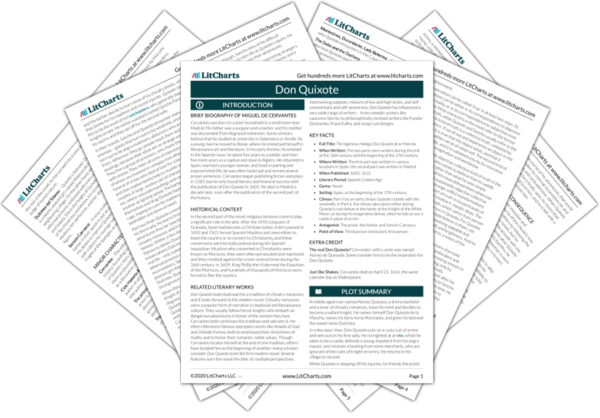Summary
Analysis
Quixote is delighted to be on the road once again, free from love affairs, luxuries, and obligations. Sancho is happy because the butler gave him two hundred escudos for emergencies. They come across a dozen farmers sitting next to large objects covered in cloth. One of the farmers unveils the objects, explaining that they are wood sculptures for a village church. Quixote says that all the Christian saints depicted by the sculptures were fine knights, because they fought to help the helpless and defend their nations. He considers the encounter a good omen. The difference between saints and knights, he says, is that saints fight like angels, and knights fight sinfully, as all men.
The novel as a whole traces the transformation of Sancho and Quixote’s characters. But the transformation is not smooth and steady – rather, it is cyclical. Both men evolve by leaps and bounds, sometimes acting like their new selves and sometimes like their old ones – a realistic depiction of personal change. Because the two friends have gotten a new start, they briefly act like the people they were when the novel began: Quixote is optimistic and carefree, and Sancho is simple and a little greedy.
Themes
The men ride away, and Sancho tells his master that this was the gentlest adventure they’ve ever had. Quixote agrees and warns Sancho not to take omens too seriously, because sometimes they are only coincidences. Sancho comments that Altisidora’s flirtations were very brazen, and Quixote explains that true love strips the heart of shame. Sancho wonders why a beautiful young girl fell in love with a scrawny old man. Quixote tells him that there is both a beauty of the body and a beauty of the soul, which is visible in a person’s virtue and kindness.
Quixote can’t seem to make up his mind about signs and omens. He often interprets objects and events as good or bad omens, but he doubts that any such thing as an omen can exist. How is a person to know whether something is an omen or a coincidence? Something becomes an omen under the charm of a creative interpretation. Quixote is beginning to doubt his interpretations, which used to seem invincibly true to him.
Themes
Suddenly, Quixote gets caught in a slim green net hanging from a tree. Two beautiful girls costumed as shepherdesses come out from the forest and explain that they and a group of their friends and family are playing at “creating a new pastoral Arcadia,” and that they hung the nets to catch birds. They invite the friends to be their guests. Quixote thanks them, introduces himself, and offers his knightly services. The girls are delighted to meet Quixote himself, of whom they’ve read in the famous chronicle. The two friends join the company for lunch.
In the first part of the novel, Sancho and Quixote encountered several shepherds and shepherdesses. Now, in the self-consciously fictionalized second part, they encounter pretend shepherdesses. Many of the people the two friends encounter - these imitators, the troupe of actors, and the disguised puppet master/ former bandit – are not what they seem to be. Sancho and Quixote are learning that personality is often a type of performance.
Themes
Quixote thanks the girls for their hospitality and promises to profess their unsurpassed beauty (surpassed by none except Dulcinea) at the jousts in Saragossa. He rides out to the road to profess the girls’ beauty, when he sees some herdsmen guiding a herd of bulls; Quixote refuses to get off the road until the herdsmen acknowledge the beauty of the shepherdesses, and the two friends get badly trampled. They set off again, hanging their heads in shame.
Quixote is snapped back to his more fallen state by yet another physical and emotional humiliation. The friends have escaped the lies and complications of court society, but even the wilderness of the road shelters actors and contradictions.
Themes
Get the entire Don Quixote LitChart as a printable PDF.













